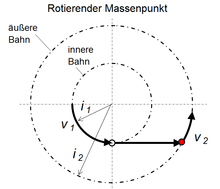Pirouette effect
The pirouette effect is the increase or decrease in the speed of rotation caused by the Coriolis effect , which occurs when the mass of a rotating object is pulled closer to or further away from the axis of rotation . The effect can be experienced in everyday life in the eponymous pirouette in figure skating . Figure skaters first set themselves in rotation with their arms outstretched to the side. Keeping the arms close to the body reduces the runners' moment of inertia . Since the angular momentum is retained, the angular velocity of the rotation increases. Conversely, the speed of rotation decreases when the arms are stretched out.
Gymnasts and high divers use the same principle when doing somersaults or twists . In the air, arms and legs are drawn in, in order to gain the fastest possible turn from the angular momentum obtained when jumping. Opening the posture before hitting the ground reduces the turning speed and allows a standing landing.
The pirouette effect also occurs with other rotary movements, for example with a tornado in the development phase. In the case of a supernova , the interior of the star collapses, the resulting neutron star then has rotation times in the millisecond range.
Physical basics of the pirouette effect
| Physical size | Formula symbol | SI units |
|---|---|---|
| Angular momentum | N · m · s, kg · m 2 / s | |
| speed | m / s | |
| Dimensions | kg | |
| Angular velocity | rad / s | |
| Radius of gyration | m | |
| Rotational energy | N m, kg m 2 / s 2 | |
| Lifting work | N m, kg m 2 / s 2 |
The angular momentum can be expressed as the product of the radius of gyration , mass and angular velocity :
Due to the conservation of angular momentum, the following applies to a system without external influences and unchanged mass, where the indices and denote two states of the system:
This means that the angular velocities are inversely proportional to the squares of the radii of gyration:
For point masses at a distance , the circumferential speed can be used instead of the angular speed, so that:
Since the rotational energies is, applies
With constant mass , if, for example, the radii of inertia and one of the angular velocities are known, the other angular velocity, the rotational energies and the lifting work can be calculated using the above formula .

The lifting work can also be determined directly:
The pirouette effect is an interplay between lifting energy and rotational energy. The difference between the rotational energies is the lifting work that can be converted back into rotational energy when changing to a smaller radius; d. that is, reducing the radius requires increasing effort over the distance . When the radius is increased, the energy bound in the rotation is released.
The radius of gyration of a mass point is its distance from the axis of rotation. If there are several mass points, this effective distance is determined by adding up the contributions of all masses with their respective radii :
For rigid bodies that do not rotate about a main axis of inertia , which is generally the case for mass points that interact with one another and are not in a plane perpendicular to the axis of rotation, conservation of angular momentum must be
with the inertia tensors and are assumed.
Trigonometric explanation
The rotating mass point is offset from the radius to the radius , for example by extending the connection with the pivot point. The mass moves tangentially in a straight line to the outer path. It takes the speed and the rotational energy from the inner radius as kinetic energy up to the radius :
On the outer radius, the speed can be broken down into the components and . is the new peripheral speed, and is the imaginary radial speed, which, however, because it is on the new radius = zero, can be converted into lifting work.
| Physical size | formula |
|---|---|
| Peripheral speed 2 | |
| Radial vector | |
| Rotational energy difference |
The type of transition to another radius is irrelevant for the final state. In practice the movement will be spiral, but the result is that the values for energy and speed correspond to the simplified example.
Individual evidence
- ↑ Sports mechanics, section “Angular momentum and conservation of angular momentum”, Fig. 70 on p. 78.
literature
- G. Bäumler: Sports Mechanics: Basics for Study and Practice . BLV Verlagsgesellschaft, Munich Vienna Zurich 1981, ISBN 3-405-12435-2 .
- D. Halliday, R. Resnick, J. Walker: Physics . 2nd Edition. WILEY-VCH Verlag GmbH & co. KGaA, Berlin 2009, ISBN 978-3-527-40645-6 .












































